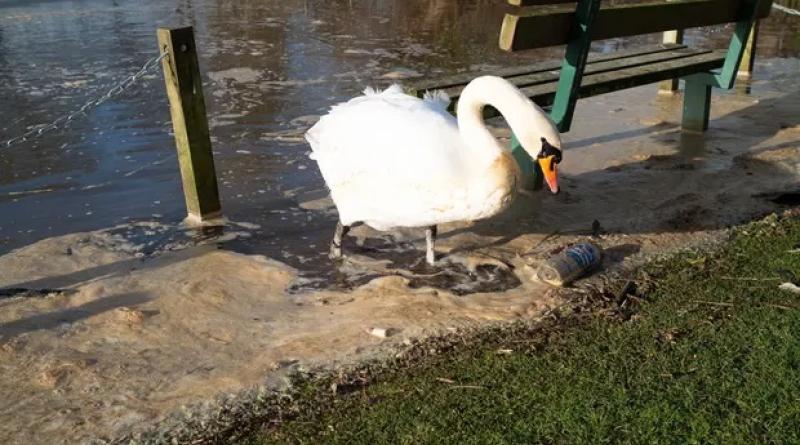30 water treatment works released 11bn litres of raw sewage in a year, study suggests

Eleven billion litres of raw sewage were discharged from a sample of 30 water company treatment works in one year, new research suggests.
The study aimed to reveal the volume of discharged effluent released from storm overflows by water firms. Companies are not forced to reveal the volume of raw sewage released during discharges. They are only required by regulators to provide data on the number of discharges and the length of time they lasted.
Recommendations by MPs on the environmental audit committee that volume monitors be installed by water companies have so far been rejected by ministers.
In a study of 30 treatment works in 2020 run by nine of the 10 water and sewerage companies in England and Wales, the volume of raw sewage discharged was estimated at 11bn litres – or the equivalent volume to 4,352 Olympic pools.
Prof Peter Hammond, a mathematician who analyses data on sewage discharges, carried out the research. He has previously given evidence to MPs to reveal that the scale of illegal discharges of raw sewage by water companies is 10 times higher than official data suggests.
Hammond said it was vital to establish the volume of sewage discharges by water companies. He said his research suggested the government’s target to reduce raw sewage releases to 20 per year by 2025 was not robust because there was no requirement to reveal the volume of raw sewage discharged for each release.
“There is still no data readily available showing the volume of untreated sewage discharges,” he said. “Water companies have some idea, but the regulators [Ofwat and the environment agencies in England and Wales] and the government [the Department for Environment, Food and Rural Affairs] probably have no idea. Sewage detritus in rivers, on beaches and in seas offers clues but may not reflect the volume of discharges.
“So what is the potential discharge volume for 20 spills per overflow per year?”Of the 30 treatment works analysed, only one – Mogden sewage treatment works in west London – has volume monitors fitted. In 2020, Mogden, which serves more than 2 million people, released a volume of raw sewage equivalent to 2,768 Olympic pools.
The average volume of sewage discharged per spill from the other 29 treatment plants in 2020 was 1.3 Olympic pools. The government target of 20 spills per year by 2025 would therefore still involve huge volumes of untreated sewage, according to the analysis.
“Even if the government’s storm overflow discharges reduction plan target of 20 spills per overflow per year were to be achieved, some treatment works could still discharge a volume equivalent to 26 Olympic pools of untreated sewage annually,” Hammond said.
Measuring the volume of discharges was vital to establish the environmental impact of them upon rivers, he said. “Individual rivers receive direct, simultaneous discharges of untreated sewage from multiple storm overflows on their journey from source to sea,” Hammond said. “So, during longer spills, the lower reaches of a river may already be polluted from upstream discharges when yet more overflows downstream discharge untreated sewage.”The River Nidd in North Yorkshire, one of the river catchments studied by Hammond, receives untreated sewage discharges from at least seven treatment works. Calculations were possible on estimated volumes for four treatment works: Pateley Bridge, Harrogate North, Darley and Kirk Hammerton. Hammond estimated the river received an equivalent of 317 Olympic pools of raw sewage from those works in 2020.
David Clayden of the Harrogate Flyfishers’ Club and a member of the Nidd Action Group, said he saw no reason water companies could not reveal the volume of raw sewage being discharged into rivers. The group is carrying out testing on the river helped by the University of Leeds. They are working on an application for bathing water status for a section of the Nidd known as the Knaresborough Lido, to drive a clean-up.
“There is a real buzz about this issue here as there is nationally,” he said. “It is extraordinary to see estimates of the volume being discharged. I am very disappointed that the government did not follow the recommendations of the environmental audit committee and make water companies fit volume monitors.”
Data from treatment works run by Welsh Water that feed into the Conwy, a sea trout river in north Wales, was also studied. Hammond estimated the volume of discharges from both inlets and storm tank overflows was an equivalent to 34 Olympic swimming pools.
Volumes at the 29 treatment works that did not have monitoring were estimated in one group by calculating the difference between flow meters at the inlet where raw sewage arrives and outlet where treated effluent is discharged. During spills of raw sewage, Hammond estimated the volume of raw sewage being released rather than treated, as the difference between the two meters.
At another group of treatment works Hammond had to estimate the volume by analysing data from overflow weirs, start and stop times on event duration monitors and flow to treatment meters – something he accepts was the least reliable approach.
The water industry has promised to triple investment in the sewerage network to £10bn this decade as it apologised for not acting on sewage pollution. Clayden said his group was waiting to hear details from Yorkshire Water about what that meant for cleaning up the Nidd.
A Yorkshire Water spokesperson said: “In the short time we’ve had to review this report we’ve identified several industry-wide claims we don’t recognise … The report focuses on potential impact of storm overflows at Pateley Bridge, Harrogate North, Darley and Kirk Hammerton. We are aware of an instrument issue that was identified in the 2020 Pateley Bridge return, which overinflated discharges from the 6x overflow and paints a false picture of the overflows.
“This monitoring is being replaced and was discounted in the 2021 and 2022 returns. Storm overflows are not identified by the Environment Agency as reasons for these sections of the Nidd not achieving good ecological status. The assessments suggests that where Yorkshire Water can make a difference is in reducing phosphorus from final effluent of wastewater. That is why we are investing £790m by 2025 in phosphorus removal.”
cover photo:Water companies are not forced to reveal the volume of raw sewage released during discharges. Photograph: Maureen McLean/Rex/Shutterstock






